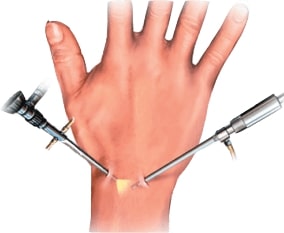Wrist arthroscopy
What is wrist arthroscopy ?
 Minimally invasive wrist arthroscopy surgery allows you to see the inside of the wrist joint using a miniaturized camera that is introduced through small incisions. This method is used to both identify and treat joint damage in the wrist, providing benefits such as faster recovery, minimal scarring and simplified post-operative procedures compared to traditional surgical procedures.
Minimally invasive wrist arthroscopy surgery allows you to see the inside of the wrist joint using a miniaturized camera that is introduced through small incisions. This method is used to both identify and treat joint damage in the wrist, providing benefits such as faster recovery, minimal scarring and simplified post-operative procedures compared to traditional surgical procedures.
What are the alternatives to this technique ?
More invasive surgical options like wrist arthroscopy may be offered, such as arthrodesis, which involves fixing the joint surfaces using screws, staples or plates. This approach is used to treat serious wrist disorders, particularly advanced osteoarthritis. Arthrodesis is used to maintain joint stability by fusing adjacent bones, which helps relieve pain and improve joint function in situations where other less invasive treatments are not effective.
Why undergo this surgery ?
The decision to perform wrist arthroscopy may be made for various reasons. Using a miniaturized camera allows a surgeon to see inside the wrist joint during this minimally invasive surgical procedure, which can be helpful in identifying and treating different joint conditions. Wrist arthroscopy is frequently used to examine joint damage, repair certain ligament injuries, treat persistent pain, detect joint abnormalities and perform specific therapeutic procedures. In addition, it is advisable to perform wrist arthroscopy in order to evaluate and treat the effects of trauma, degenerative or synovial diseases, or to obtain an accurate diagnosis in cases of persistent wrist pain.
How is this surgery carried out ?
A complex surgical procedure called wrist arthroscopy is performed under local anesthesia. The surgeon makes small incisions of a few millimeters to introduce an arthroscope, a medical optical instrument, which allows the inside of the wrist joint to be explored without completely opening the area. Thanks to this minimally invasive method, it is possible to precisely visualize the different joint structures, such as ligaments, cartilage, synovial membrane and possible debris. Wrist arthroscopy has the advantage of faster recovery, almost invisible scars, and generally does not require general anesthesia or hospitalization. Thanks to this method, the surgeon can identify and treat different wrist conditions, while reducing the risk of complications after the operation and offering a less invasive alternative to traditional surgical interventions.
Is it painful ?
Wrist arthroscopy may cause pain after surgery. It is possible to relieve this pain by using anti-inflammatory and analgesic treatment during the first days after the procedure. It is also mentioned that algodystrophy, a painful and inflammatory condition, can occur after wrist arthroscopy and requires a specific approach including adapted rehabilitation, additional examinations and sometimes specific pain management. It should therefore be emphasized that pain after wrist arthroscopy may occur, but it can be treated appropriately.
How long is the recovery time after wrist arthroscopy ?
Depending on each particular situation, the recovery time after wrist arthroscopy may differ, but as a general rule, rehabilitation and recovery of wrist mobility and strength can be achieved within a few weeks. During this recovery period, the patient can regain joint stability, reduce pain and promote a gradual return to daily activities.
What are the advantages ?
Wrist arthroscopy has several benefits such as the absence of significant scarring, reduced tissue dissection to access the joint, minimal internal scarring, generally faster recovery compared to open surgery, zoomed and detailed visualization, as well as the development of new cutting-edge surgical techniques.
Are there any risks associated with this surgery ?
Indeed, there are dangers associated with wrist arthroscopy. These risks may include complications such as bruising, infections, nerve problems, stiffness, recurring pain, decreased strength, progression to osteoarthritis of the wrist, and other rarer complications. When making the decision to undergo wrist arthroscopy, it is essential to consider these potential risks and discuss these aspects with the surgeon in order to make an informed decision.
Conclusion
In summary, wrist arthroscopy is a small-incision surgical procedure used to diagnose and treat various joint conditions of the wrist. Benefits of using this method include faster recovery, reduced scarring, precise vision of joint structures, and advanced treatment options. However, it should be emphasized that this procedure carries risks, such as infectious complications, nerve damage, stiffness, and other possible complications. It is important to make the decision to undergo wrist arthroscopy by taking into account the benefits and risks, discussing with the surgeon in order to make an informed decision.